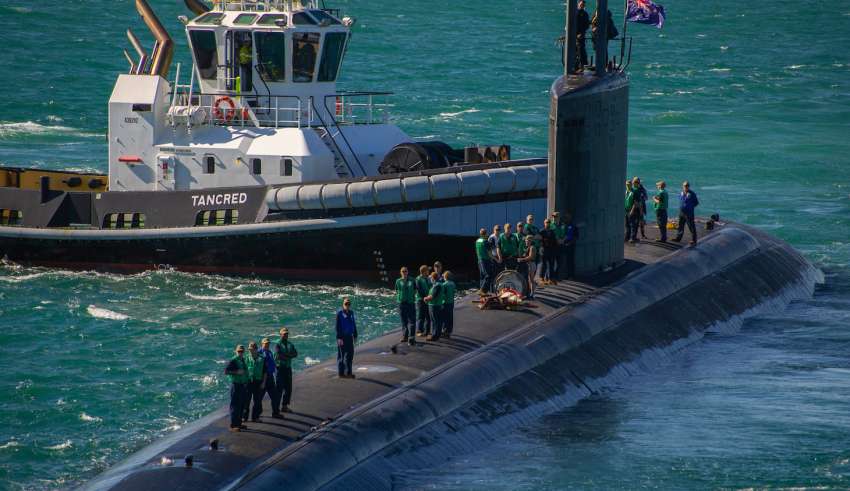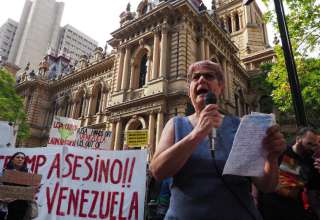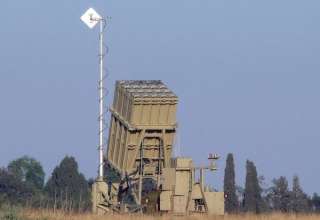By Bevan Ramsden
Successive Australian governments have allowed the United States to carry out a program of militarisation in Western Australia which has made it a vital U.S war-fighting base and thus an inevitable target for retaliatory strikes should hostilities commence, for example between the U.S and China. Much of this militarisation has been carried out behind a cloak of secrecy, without any public or parliamentary debate. This raises the question of how much the W.A public and Australians generally, know about this U.S military build-up, its implications and the serious hazards it poses.
Western Australia first became host to a vital US war fighting facility on 16th September,1967 when a submarine communications radio station named the U.S. Naval Communication Station North-West Cape was declared open. The US paid a peppercorn rent for the land but the structure was designed, built and paid for by the US. A year later, in order to make it appear more Australian, it was renamed, Naval Communication Station Harold E. Holt after the former Australian PM of that name. It is a joint Australian and United States naval communication station located on the north-west coast of Australia, 6 kilometres north of the town of Exmouth. The station is operated and maintained by the Australian Department of Defence on behalf of Australia and the United States.
The huge radio antenna covers many hectares and with a centre mast 387 metres tall making it, for many years, the highest man-made structure in the southern hemisphere. The antenna is driven by the most powerful radio transmitter in the southern hemisphere. One million watts of VLF power at 19kHz enables the radio waves to penetrate sea water and communicate with US nuclear powered and armed submarines whilst they remain submerged over vast areas of the Indian Ocean and Western Pacific. In a war scenario, the US command to launch nuclear armed missiles can be sent to their US nuclear submarines from this radio facility on the tip of the Exmouth peninsula.
In the shadow of this huge VLF antenna, the US has now established the Space Surveillance Telescope (SST) having shifted this 232 tonne piece of equipment, according to Andrew Fowler in his book “Nuked”, from White Sands Missile Range in New Mexico- famous as the site of the Trinity atomic bomb test in 1945- to the far west coast of Australia. The SST is the world’s largest parabolic mirror enabling the scanning and photographing of geosynchronous satellites. It is owned and operated by the US Space and Missile Systems Office and provides information, according to the Pentagon’s own statement, for the USSF to be “combat ready” to “fight to protect and defend the US and its Allies from attack in, through and from space”. According to Andrew Fowler, “the main function of the SST is to identify and pre-emptively target a space adversary, even if they are not attacking and knock them out, giving the United States superiority in any confrontation.”
Another US installation at North-West Cape, close to the SST is a giant radar shipped in, according to Andrew Fowler, by the US from the Caribbean to track low orbiting satellites and missile launches. “Together, says Andrew Fowler, “the SST and the radar are a formidable duo supporting US military war-fighting capabilities. The radar and the high quality telescope integrate Australia further into the US military in a particularly dangerous area: where America and China are facing off in space. Its where a nuclear war could start”, says Andrew Fowler.
The WA city of Geraldton, 419 km north of Perth, now features in the US military build-up because it hosts the Kojarena Satellite Communications facility. Whilst titled the “Australian Defence Satellite Communications Station”, Kojarena was built and paid for by the United States and provides advanced communications for the United States and Australian military. An Australian Defence Force spokesperson has confirmed the new facility, which will be called the Combined Communications Gateway Geraldton, offers real-time operational and logistical information essential for command and control of deployed forces which would include US and Australian forces in a war against China.
Further north, south east of Derby and 170 km east of Broome, the Curtin RAAF base is receiving upgrades and extensions enabling the servicing of US and Australian fighter jets and bombers. Together with similar upgrading of RAAF Scherger in North Queensland, the two provide back-up airfields should RAAF Tindal be taken out by an enemy missile. RAAF Tindal is now home to US B52, nuclear capable bombers which can fly to China and back without re-fuelling and could attract missile attention in a US war against China.
Much closer to Perth, WA’s capital, is the HMAS Stirling naval base on Garden Island off the coast of Rockingham. This base is currently receiving an $8 billion upgrade, part of the huge expense arising out of the commitment made by the Australian Government under the AUKUS war pact with the UK and to enable the porting, maintenance and re-suppling of their nuclear submarines and disposal of their low- level nuclear waste. Senator David Shoebridge has warned that intermediate level nuclear waste would also be allowed under the current Bill before Parliament. The Australian Naval Nuclear Power Safety Bill, 2023 has declared a “nuclear zone” around Garden Island and the Australian Radiation Protection and Nuclear Safety Authority (ARPANSA) has evaluated the impact on this nuclear zone of possible nuclear radiation leaks or accidents associated with visiting nuclear submarines. The workers and local community living or working within this nuclear zone have not been advised that forced evacuation to decontamination centres and the need to take iodine pills could be necessary in the event of such accidents or leaks from the nuclear reactors propelling these foreign submarines. ARPANSA warned that a catastrophic accident could have serious long term health effects.
Since it is US policy neither to confirm nor deny whether or not its nuclear submarines are carrying nuclear missiles and because our government “understands and respects” this US policy, it is highly likely that in a war situation US nuclear submarines porting at HMAS Stirling could be carrying nuclear weapons.
Secrecy and lack of transparency of government decisions means that the public has not been told that these vital US military facilities have made particular Western Australian locations targets for attack by an enemy of the US in the event of war, such as a war against China.
These issues and the development of strategies to keep Australia out of foreign wars will being discussed in detail at a National Conference of the Independent and Peaceful Australia Network on the weekend of 4-6th October, in Perth. The Conference is titled “Sleepwalking into War?” and will feature speakers including former WA Premier Dr Carmen Lawrence, Senator Fatima Payman, Emeritas Professor Ian Lowe AO, Professor Richard Tanter, former Australian Ambassador John Lander and Senators David Shoebridge and Jordan Steele-John. Details and registration at https://tinyurl.com/3bchdddp







